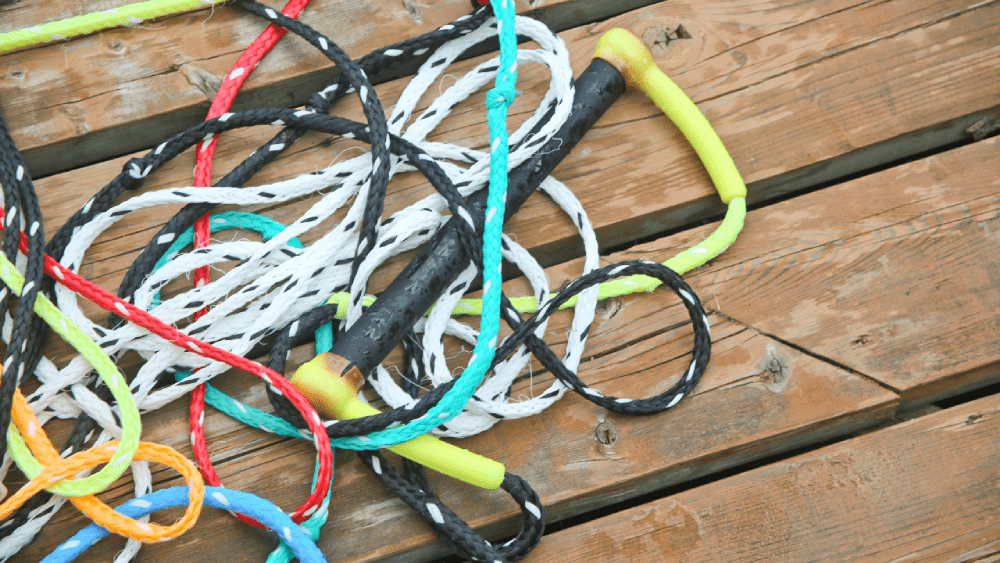How Long Should A Water Ski Rope Be?
Wes Severson July 7th, 2023 Posted In: Articles Tags: Wake
When it comes to water skiing, having the right equipment is crucial for an enjoyable and safe experience, especially when you know how to water ski. One essential piece of gear is the water ski rope. But how long should a water ski rope be? In this article, we will explore the ideal lengths for water ski ropes with both single-ski and double-ski water skiing.

Understanding Water Ski Rope Lengths:
When it comes to water ski rope lengths, the ideal length varies depending on whether you’re using a single-ski or double-skis.
Rope lengths for double-ski water skiing
The recommended rope length for double-ski water skiing ranges from 45 to 85 feet. A general rule of thumb is that a longer rope is better for beginners. That’s because, a longer rope provides greater stability, which makes them better suited for newcomers or those who prefer a more relaxed skiing experience. For recreational and leisure skiing, a longer rope will allow skiers to turn with a wider arc for easier maneuverability.
Shorter ropes, however, offer the ability to perform quicker turns and more aggressive tricks, making them ideal for more experienced double-ski skiers seeking more challenging maneuvers. Using a shorter line that is roughly 45 to 60 feet in length is typically used for trick skiing and acrobatic water skiing on two skis.
Rope lengths for single-ski water skiing
The recommended rope length for single-ski water skiing really depends on your skill level. Figuring out how long a water ski rope should be varies quite widely, typically between 20 to 75 feet. The large variation in length allows skiers to perform wider turns with longer ropes or tighter turns with shorter ropes. Longer ropes provide a wider turning radius and are more geared toward beginners or those who prefer a smoother ride. In contrast, shorter ropes enable more aggressive maneuvers and tighter turns, which are favored by experienced skiers.
For beginner and intermediate water skiers, a good rope length on a single ski is anywhere from 60 to 75 feet. The longer ropes provide greater stability and less boat spray, making them suitable for beginners or those who prefer a more relaxed skiing experience. This length provides a good balance between stability and maneuverability while allowing the skier to maintain proper tension on the rope. The length you choose may also vary depending on boat speed and personal preference, as you begin to figure out what feels best for you.
Single-ski short-line skiing
For advanced riders who want agility and maneuverability, short-line skiing will likely be the path you choose. The typical length runs from 20 to 35 feet. It’s important to note that short-line skiing requires a higher level of skill, experience, and physical fitness compared to recreational water skiing. Here are the main advantages of short-line water skiing.
- Increased Challenge: Short-line skiing offers a greater level of challenge compared to skiing on longer ropes. The shorter rope length requires the skier to make quicker and more precise turns, enhancing their skill and control on the water.
- More Speed and Performance: With a shorter rope, the skier can maintain higher speeds and achieve tighter turns. This allows for faster acceleration and increased performance, resulting in a thrilling and exciting skiing experience.
- Enhanced Precision: Short-line skiing demands greater precision in executing turns, cuts, and jumps. Skiers need to be more precise with their movements and weight distribution to navigate through the slalom course or perform tricks effectively.
- Improved Technique: Short-line skiing encourages skiers to refine their technique and form. The shorter rope length requires a more aggressive stance, increased edge control, and better weight distribution. This helps skiers develop better body positioning and overall technique.
- Competitive Advantage: Short-line skiing is the focus of competitive slalom skiing events. By practicing short-line skiing, skiers can improve their performance and skill level, preparing them for participation in competitions and tournaments.
- Freestyle Potential: Short-line skiing provides opportunities for skiers to explore freestyle skiing, including jumps, tricks, and flips. The increased speed and control afforded by the shorter rope can enhance the execution of various freestyle maneuvers.

Other Things To Consider
Here are some additional factors to consider when you’re trying to answer the question, how long should a water ski rope be?
- Boat speed: The faster the boat, the longer the rope you need.
- Water conditions: If you are skiing in choppy water, you will need a shorter rope.
- Your weight: Heavier skiers need a longer rope.
Tips For Choosing a Water Ski Rope:
- Look for a rope that is made of high-quality materials and has good tensile strength.
- Choose a rope that is the right length for your skill level and the type of skiing you want to do. Do not overestimate your ability.
- Make sure the rope has a comfortable handle that is easy to grip.
- Consider buying a rope with a built-in bridle, which will help to keep the rope away from the propeller.
To Wrap It Up
Choosing the right water ski rope length is essential for optimizing your water skiing experience. Understanding the variations in rope lengths for single-ski and double-ski water skiing can help you tailor your performance to your desired style. So, grab your rope, hit the water, and have a blast while keeping safety in mind!

